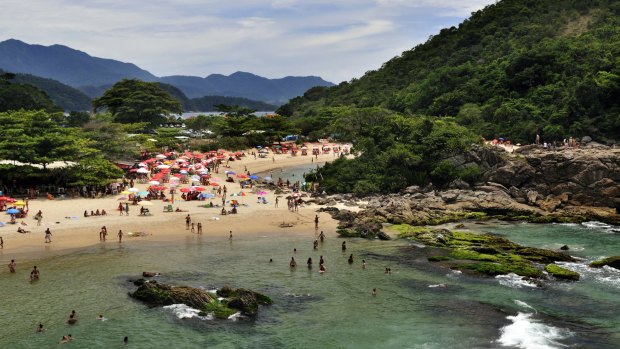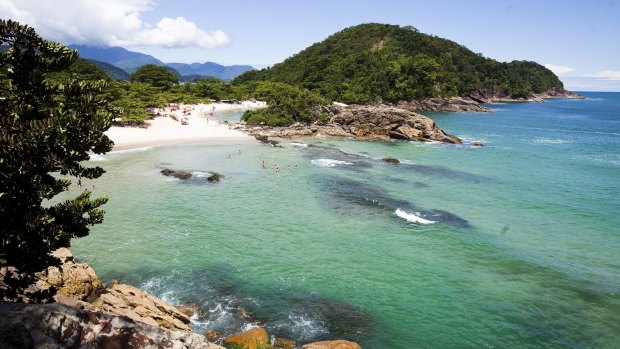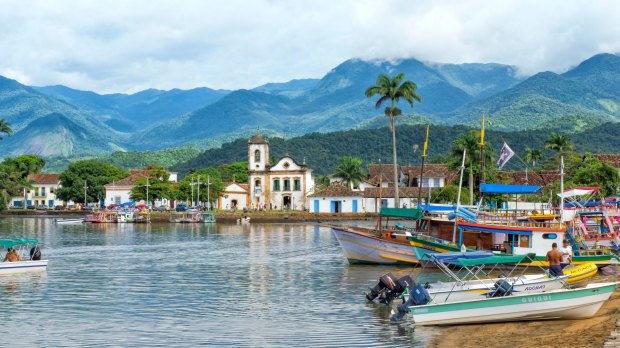This was published 4 years ago
Brazil, Costa Verde: A Brazilian beach-lover's road trip

Busy beach in Trinidade, Paraty.Credit: Alamy
For a city with a laid-back reputation, Rio de Janeiro is home to a great many lunatic drivers. The average tourist comes here to sashay along promenades and people-watch at some of the world's most famous beaches but if, like me, you want to drive west along the sumptuous Costa Verde to reach the colonial port of Paraty, a car is a necessary terror.
The journey along this stretch of coast between Rio de Janiero and Sao Paulo is not relaxing – well, not at first, for an hour or so through the city's traffic. In terms of landscape, however, Rio provides a good preview of what's to come: green peaks lurching skywards; yawning bays like giant mouths attempting to swallow great sections of the Atlantic; and sand – beaches beyond beaches, almost all dappled with Brazilians deepening their mahogany tans. The Costa Verde has all this, with charming little towns dotted along the way. In places it feels as though the rainforest might tumble into the sea like a green wave.
On the way to Party, 260 kilometres south-west of Rio, my first stop is Angra Dos Reis – Creek of the Kings – which was named by early Portuguese explorers as they mapped more and more of a vast coastline they would soon claim as their own. Angra Dos Reis, which has been inhabited since 1556, is made up of 365 of islands and today it's the major departure point for visiting the wild isle of Ilha Grande. Once a leper colony and the site of a notoriously dreadful prison, there are still no roads or any significant cars on the island yet it is becoming increasingly popular as a soft adventure destination. My waiter in Zero Grau Chopperia is absolutely horrified that I won't be visiting it. He makes a disgusted face at my "nao" when I tell him I'm only going to Paraty.

Trindade, Paraty.Credit: iStock
It's tempting to push on from here directly to my destination, but I realise that for all the kilometres I've covered so far, I am yet to set foot on sand. Part of my reluctance stems from the overwhelming choice. The Costa Verde has beaches which range from colossal to minuscule, rough to smooth, grandiose to petite. Unable to make a decision, I resolve to just stop at the next one, whatever it may be.
That, as it turns out, is the unpronounceable Tanguazinho. Without a guide, I'm reduced to checking Google Maps for recommendations and, handily, Brazilians rate beaches like the French rate restaurants and the British rate pubs – which is to say, frequently and earnestly. What the locals here are actually judging it on is a mystery but Tanguazinho has a solid 4.8 out of 5.
I climb down a set of decaying stairs to reach a sheltered cove, golden sand leading to a still bay. Paddle boarders make for serene silhouettes while couples canoodle in the shadows. By any score, this is blissful and, with a warm breeze enveloping me, I soon doze off.

Santa Rita Church, Paraty.Credit: Alamy
When I wake, I'm realise I'm losing time so I drive directly to Paraty to check into the remarkable Pousada Literaria. As nice as the hotel is, based in a colonial building, I'm worried that sitting down will result in lying down, which will result in more sleep, so instead I head out into the humid evening to have a look around.
It's January and the month-long Carnival celebrations are still several weeks away, yet preparations here are well underway. For some, this mean squirrelling themselves away indoors to sew extraordinarily gauche outfits, but for others it means getting outside to bang a drum, blow a whistle, or simply check that the old hips still swing the way they want them to.
I try to find a bar and come across a ramshackle band, slowly making its way through the old Portuguese streets. The leader is a lean man with a moustache wearing a flat-cap. His drumsticks, like magic wands, are capable of halting or accelerating his rhythmic army of dancers and musicians.
I follow them for almost an hour, songs rolling one into another, the band growing and shrinking as new members join and others tire. Throughout, a snare drums rasps like hail and a whistle cuts through the din to let people know whether to stand still or march along. At one point, a toddler joins in, their cuteness almost putting everyone off the beat; at another, a dog approaches, seemingly outraged at having missed the invite. Its bark is the only thing out of time.
This is all very satisfying to a European like me and even though my feet feel utterly leaden compared to the locals', and although a little part of me worries about the sonic boom of the bass drum damaging this gorgeous heritage-listed town, the party atmosphere is impossible to resist.
The following morning the sun ricochets off the city's whitewashed walls and intensifies my hangover. In this brilliant caipirinha-free daylight it's easier to see the layout of the town. The cobbled streets over which I'd stumbled the night before are no more user-friendly now: huge, impractical things seemingly designed to turn ankles. They're such a challenge to traverse, the night's dancing seems to me all the more miraculous. They're not just a challenge for humans, either – this close to the shore, dozens of little crabs clamber hither and yon. To them, the stones must seem mountainous.
Paraty is modernising rapidly, becoming more and more popular as a bohemian retreat. Originally, though, this port existed to facilitate the worst kind of capitalism. As the colonial Portuguese pillaged the interior of Brazil, Paraty served as the main point of export for their stolen riches. Slaves arrived as gold left, and despite the gorgeousness of the setting, it's difficult to ignore that historic ugliness.
After Brazil's independence from Portugal in 1822 Paraty fell away from memory, abandoned almost completely for more than a century. It wasn't until the construction of a new road in the 1960s – until then it was only accessible by boat – that the town to sprang into a new, glorious life.
To see tourists gingerly navigating the uneven streets and the samba groups dance between the newly whitened walls, it's hard to imagine this place in a state of disrepair.
I'm supposed to jump back in the car and return to Rio, but the city can wait. Instead I a find a cafe, order a cold beer and watch the world go by a little longer.
THE DETAILS
Jamie Lafferty was a guest of South America Travel Centre.
MORE
FLY
LATAM operates flights to Rio from Melbourne via Santiago in Chile; from Sydney it's necessary to head to Melbourne or Auckland before crossing the Pacific. See latam.com
TOUR
Paraty is 260 kilometres south-west of Rio. South America Travel Centre can tailor tours to there and other locations in Brazil. See southamericatravelcentre.com.au
Sign up for the Traveller Deals newsletter
Get exclusive travel deals delivered straight to your inbox. Sign up now.